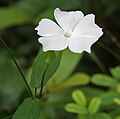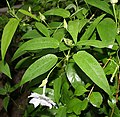Thunbergia
| Thunbergia subsp. var. | ||||||||||||||||||||||||||||||||||||||||||||||||||||||||
|---|---|---|---|---|---|---|---|---|---|---|---|---|---|---|---|---|---|---|---|---|---|---|---|---|---|---|---|---|---|---|---|---|---|---|---|---|---|---|---|---|---|---|---|---|---|---|---|---|---|---|---|---|---|---|---|---|

|
|
| ||||||||||||||||||||||||||||||||||||||||||||||||||||||
| ||||||||||||||||||||||||||||||||||||||||||||||||||||||||
Thunbergia is a genus of flowering plants in the Family Acanthaceae, native to tropical regions of Africa, Madagascar and southern Asia. Its members are known by various names, including thunbergias; clockvine on its own usually refers to Thunbergia grandiflora, while Thunbergia alata is often known as Black-eyed Susan vine or just Black-eyed Susan (not to be confused with other flowers called Black-eyed Susan). Orange clockvine is the name of Thunbergia gregorii.
Thunbergia was named for Carl Peter Thunberg.
Thunbergias are vigorous annual or perennial vines and shrubs growing to 2-8 m tall.
Some are frequent garden escapes, becoming invasive species; they are regarded as environmental threats in Australia, for example.
| Standard Cyclopedia of Horticulture |
|---|
|
Thunbergia (after Karl Peter Thunberg, professor of botany at Upsala and successor to Rudbeck and Linnaeus; died 1828). Acanthaceae. Mostly tall perennial climbers producing flowers in great profusion; greenhouse, and in the open far South. Leaves opposite: fls. blue, yellow, purple, or white, solitary and axillary or in racemes; calyx annular and scarcely lobed or toothed or 10-15-toothed, surrounded by 2 large bracts which often inclose also the corolla-tube; corolla trumpet-shaped, with a spreading limb, tube curved or oblique, often compressed, enlarged toward the mouth; stamens 4, didynamous, fixed near the base of the tube, filaments thickened at the base, separate; anther-cells parallel, equal, mostly mucronate at the base: ovary seated on a fleshy disk, 2-loculed, each cell with 2 ovules (rarely only 1). The Thunbergieae are distinguished by the contorted corolla, the 4-seeded caps., and the globose seeds.—About 75 species, in the tropics of the world, particularly in Afr. The thunbergias are nearly all vigorous greenhouse climbers resembling allamandas in habit. In large conservatories where they are not cramped for room they flower freely and display their flowers to the best advantage. Severe pruning, which is necessary in small greenhouses, prevents the production of flowers. The larger species, T. laurifolia, T. affinis, T. grandiflora, T. mysorensis, and T. coccinea are rapid growers, requiring plenty of feeding and root-room. All do better in open beds than in pots. They may be propagated either from seeds or by cuttings which are taken from the young wood which starts into growth after the plants have been cut back during whiter. These produce few flowers the following autumn, but bloom freely the second season. As a rule, the plants flower in late summer or autumn, but the time of flowering may be made to vary according to treatment in some species. T. alata and its varieties and T. fragrans are often treated as annual garden plants, flowering in late summer. T. erecta and T. affinis, when grown in pots, form rather compact shrubby plants. In Puerto Rico T. alata has escaped and is common. Cook writes that there are two forms, one with corolla-limb cream-yellow and other whitish. Thunbergias and allamandas are great favorites in central and southern Florida, being used on verandas, arbors, small trees, old stumps, trellises and buildings. Of the blue-flowered kinds T. grandiflora is hardiest and commonest. It has large heart-shaped leaves which overlap one another in a charming manner. It blooms from September until Christmas, the flowers being light blue and rather dull. The form of T. laurifolia known to the trade as T. Harrisii, has nearly sky-blue flowers, of a deeper but brighter hue than the preceding. It is a taller-growing and choicer plant, and has ten or more flowers in a raceme, while those of T. grandiflora are solitary in the axils. T. fragrans is the common white-flowered kind. The form cultivated in Florida is probably var. vestita, as the blossoms are not fragrant. T. alata is a general favorite. The flowers range from buff and white to orange with a deep purplish brown throat, the last form being the most popular. This species is killed to the ground by sharp frost every winter but sprouts vigorously the following spring. It also comes up from self-sown seed. This species grows only 7 to 8 feet high. All the thunbergias mentioned above are easily raised from cuttings or layers in summer. T. erecta is not a climber but has a somewhat straggling habit. It has small dark green leaves and large deep purplish blue gloxinia-like flowers which are white at the base. There is a pure white variety of it. It blooms all summer and autumn. It is readily raised from cuttings during the rainy season. T. Gibsonii, S. Moore. Sts. prostrate: lvs. about 1 in. long, triangular, glossy above: peduncles axillary, erect. 3 in. long: fls. solitary, about 1 1/4 in. across, yellow, each with a pair of inflated and united crimson-stained bracts. British E. Afr. B.M. 8604.— T. primulina, Hemsl. Perennial, silky hairy at first: lvs, rhomboid ovate, 1 1/2 – 2 1/2 in, long, with 1 small lobe on each side: fls. axillary, solitary, about 1 1/2 in. across, resembling the common primrose in shape and color. E. Trop. Afr.— T. Vogeliana, Benth. (Meyenia Vogeliana, Benth.). Erect: lvs. large, ovate or oblong, dark green; fls. about equaling those of T. erecta, deep bluish violet with yellowish throat: handsome summer-flowering species. Fernando Po, Afr. CH
|
Cultivation
- Do you have cultivation info on this plant? Edit this section!
Propagation
- Do you have propagation info on this plant? Edit this section!
Pests and diseases
- Do you have pest and disease info on this plant? Edit this section!
Species
Specieswp
Thunbergia alata
Thunbergia coccinea
Thunbergia erecta
Thunbergia fragrans
Thunbergia grandiflora
Thunbergia gregorii
Thunbergia laurifolia
Thunbergia mysorensis
Thunbergia togoensis
Gallery
Thunbergia fragrans in Talakona forest, in Chittoor District of Andhra Pradesh, India.
Thunbergia fragrans in Talakona forest, in Chittoor District of Andhra Pradesh, India.
Thunbergia fragrans in Talakona forest, in Chittoor District of Andhra Pradesh, India.
References
- Standard Cyclopedia of Horticulture, by L. H. Bailey, MacMillan Co., 1963
External links
- w:Thunbergia. Some of the material on this page may be from Wikipedia, under the Creative Commons license.
- Thunbergia QR Code (Size 50, 100, 200, 500)








